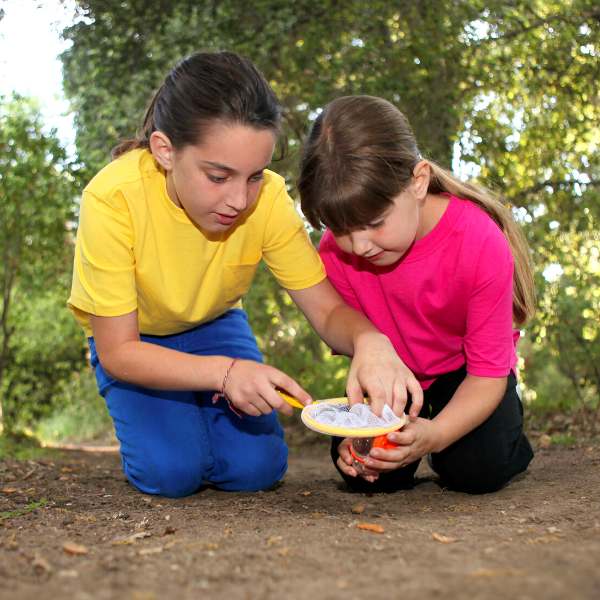Bug (or minibeast) hunts with kids can be a fun and educational activity that promotes outdoor exploration and scientific discovery. Whether you’re doing it for the first time or just want to make sure you’ve covered everything, here are some bug-hunting tips to make it a fun and memorable experience for everyone.
I’ve written these tips based on my own experience of organising bug hunts with kids in UK habitats. If you live somewhere with different habitats, or with insects that might be harmful, you’ll need to adapt accordingly.
Season
Pick your time of year carefully. During colder months, some insects might be hibernating or dormant. Late spring/early summer can be an ideal time – everything will have come back to life, but it won’t be the hottest time of year.
Choose a location
Pick a location that is suitable for a bug hunt. This could be a park, garden, school grounds, or wooded area. Make sure that the location is safe and accessible and has a variety of habitats for insects and other minibeasts to live in.
Prepare your bug hunt kit
The equipment needed will depend on the habitats you’re exploring. There are some basics that most bug hunts will require.
- Something to pick bugs up with. This could be as simple as spoons, or clean paint brushes with soft bristles that insects can crawl onto. Picking up creatures directly should be avoided – they can easily be squished!
- Clear pots for collecting, preferably with small air holes. Deep trays can also work.
- Magnifying glasses or portable microscopes for close-up inspection.
- You may also wish to use pooters (clear pots with 2 tubes that allow you to suck bugs into a viewing area), or sweep nets if you’re searching in long grass.
- Identification books, or spotter sheets – you can often find these on local/national wildlife charity websites.
You may also want to bring a camera to take photos for follow-up work.

Set your expectations.
Talk together about the best way to search for and handle any insects. Children should be careful not to trample or destroy any habitat, and to treat any bugs found with care and respect.
You may wish to leave buzzing insects like bees and wasps in-situ to avoid stings. Extra care should be taken with butterflies due to their fragile wings – again, these may be best observed in-situ.
- Carefully turn over leaves on bushes to see if anything is hiding underneath. Look out for leaves that have been nibbled! Caterpillars, aphids, ladybirds (ladybugs), and snails can all be found on leaves.
- Explore leaf litter to see what’s hiding underneath. Woodlice, earwigs, centipedes, and slugs prefer dark, damp places.
- You could also search under stones, on tree bark, in flowers or long grass.
- Don’t miss out man-made structures like window ledges and cracks in brickwork. A pocket torch can be useful for this.
Talk about your finds together
When the exploring time is up, children can share what they’ve found. Here are some points for discussion:
- What features can children see? Count legs, wings, body parts.
- Can they spot any ways in which the bugs are adapted to their habitat? E.g. crickets with long legs for jumping through grass, or the long, flat bodies of centipedes which are ideally suited to moving under stones or bark.
- Classify the bugs found into insects, arachnids, worms etc.
- You may want to leave some time for some observational drawing.
Put everything back where it came from
It’s important not to keep the minibeasts out of their habitat for too long so children should place everything back with care.
Planning for future years
If you’re bug hunting on your school grounds, you can plan ahead for future years. Setting up wild areas such as log piles, mini meadows, stones or even a pond will provide habitats to explore and make your grounds bug-friendly. In turn, you might attract other wildlife such as birds, mammals, and amphibians.
Final tips
Wear long trousers/sleeves if searching in areas where ticks might be present.
Don’t feel embarrassed if you don’t recognise what children find. Part of the fun is working together to decide what something might be. If you’re not sure, take a photo to send to a local expert.
Search the same area at different times of year to record changes in species found.
Look out for citizen science projects that kids could get involved in – these are generally run by wildlife charities and involve submitting results of what you’ve found in your local area.
If you’re a teacher or home educator looking for science resources linked to insects and other bugs, check out my TPT store – it’s packed with fun activities for primary kids.
Want to join my email list?
Grab this free sunflower life cycle template and get a weekly dose of science inspiration in your inbox. Just fill out your name and email below to join!


